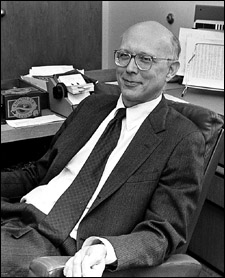Whitesides among Kyoto Prize winners:
Award for ‘pursuit of peace and betterment of society’

George McClelland Whitesides, the Mallinckrodt Professor of Chemistry at Harvard University, has been named a winner of the 2003 Kyoto Prize. Presented by the Inamori Foundation of Japan, the award is given to “people who have contributed significantly to mankind’s betterment in the categories of Advanced Technology, Basic Science, and Arts and Philosophy.” Whitesides won in the first category. Eugene Newman Parker, professor emeritus at the University of Chicago, won in basic science, and Bunraku Puppet Master Tamao Yoshida took the arts prize.
Each laureate will receive a diploma, a Kyoto Prize Medal of 20-karat gold, and a cash gift of 50 million yen (approximately $400,000) at a ceremony Nov. 10.
“Today, we are rushing ahead with incredible scientific and technological achievements, while understanding of our emotional and psychological development lags deplorably,” said Kazuo Inamori, founder and president of The Inamori Foundation. “It is my hope that the Kyoto Prizes will encourage balanced development of both our scientific and our spiritual sides, and hence provide new impetus toward the structuring of new philosophical paradigms.”
Whitesides will receive the prize for pioneering advances in material sciences that increase our understanding of how molecules can assemble themselves and how such assembly can be applied to building practical devices only a few millionths of an inch in size (nanotechnology).
“It’s a case of learning from nature,” Whitesides explained. “We look at living things and ask ourselves how they do what they do. We try to extract basic principles from this, then use them to assemble structures without human intervention. That kind of inquiry yields a better understanding of how to cross the border between chemistry and biology, between life and nonlife.”
The incredibly small nonliving structures he builds, such as transistors and diodes, will find their way into tomorrow’s faster and smaller computers. They also will be part of ultrasensitive probes to detect disease and the presence of chemical and biological weapons. These could include minute probes that pass through our blood and bodies looking for signs of poisons and disease.
On the living side of the border, self-assembled devices are already evolving into structures that closely mimic proteins, genes, nerves, and even viruses. Whitesides looks forward to a time when these structures may be used to repair nerves damaged by accidents and disease, thus restoring movement to paralyzed limbs.
“The underlying process of self-assembly is the same for living and nonliving things,” he said. “We don’t have to invent new physical phenomena. We already know it can be done because we’re doing it.”




